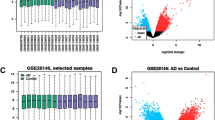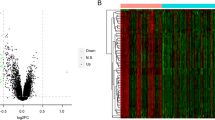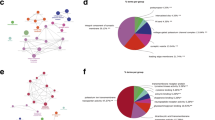Abstract
OBJECTIVE: To analyze the functions and pathways of differentially expressed genes (DEGs) between Alzheimer’s disease (AD) patients and normal controls using bioinformatics methods, and to screen Hub genes to provide theoretical support for the study of AD pathogenesis and therapeutic targets. METHODS AD-related data microarrays (GSE197505) were obtained from the GEO database, and the data were processed using GEO2R to obtain DEGs. The screened DEGs were enriched for Gene Ontology (GO) and Kyoto Encyclopedia of Genes and Genomes (KEGG) signaling pathways, using the Matascape platform. Cytoscape software was utilized to map the PPI network and screen the Hub genes. RESULTS A total of 142 DEGs were screened as down-regulated genes in this study. GO/KEGG analysis showed that these DEGs were involved in biological processes such as positive regulation of cell cycle protein-dependent serine/threonine kinase activity, and PI3K-Akt signaling pathway. Eight Hub genes were finally screened by the PPI network, four of which were validated by the literature. CONCLUSION The results of the bioinformatics network analysis revealed the Hub genes of AD, contributing to a better understanding of the mechanisms of AD and facilitating the discovery of new therapeutic targets.
Access this chapter
Tax calculation will be finalised at checkout
Purchases are for personal use only
Similar content being viewed by others
References
Prince, M.: The Global Impact of Dementia an analysis of prevalence, incidence, cost and trends. World Alzheimer Report 2015 (2015)
China dementia and cognitive disorders guideline writing group.: cognitive disorder disease specialized committee of neurologists branch of Chinese physicians association. 2018 China dementia and cognitive disorders diagnostic and treatment guidelines (I): diagnostic criteria for dementia and its classification. Chin. Med. J. 98(13), 965–970 (2018)
Alzheimer’s Disease International.: World Alzheimer Report 2019: Attitudes to dementia. Alzheimer’s Disease International, London (2019)
Ruoqi, Z.: Progress in molecular imaging of pathological markers of Alzheimer’s disease. Shanxi Med. J. 50(3), 381–384 (2021)
Barrett, T.: NCBI GEO: archive for high-throughput functional genomic data. Nucleic Acids Res. 37(Database issue), D885-D890 (2019)
Dan, L.: Long RNA profiles of human brain extracellular vesicles provide new insights into the pathogenesis of Alzheimer’s disease. Aging Dis. 14(1), 168–178 (2023). PMID: 36818567
Manish, K.: Implications of phosphoinositide 3-kinase-akt (PI3K-Akt) pathway in the pathogenesis of Alzheimer’s disease. Mol. Neurobiol. 59(1), 52–64 (2021)
Blennow, K.: Evolution of Abeta42 and Abeta40 levels and Abeta42/Abeta40 ratio in plasma during progression of Alzheimer’s disease: a multicenter assessment. J. Nutr. Health Aging 13(3), 232–236 (2009)
Dahiyat, M.: Association between Alzheimer’s disease and the NOS3 gene. Ann. Neurol. 46(4), 664–667 (1999)
Carmen, G.: Increased susceptibility to plasma lipid peroxidation in Alzheimer disease patients. Curr. Alzheimer Res. 1(2), 103–109 (2004)
Bergin, D.: Altered plasma arginine metabolome precedes behavioural and brain argi nine metabolomic profile changes in the APPswe/PS1ΔE9 mouse model of Alzheimer’s disease. Transl. Psychiatry 8(1), 108 (2018)
Jeynes, B.: Significant negative correlations between capillary expressed eNOS and Alzheimer lesion burden. Neurosci. Lett. 463(3), 244–248 (2009)
John, P.: Neurofibrillary tangles and senile plaques in Alzheimer’s brains are associated with reduced capillary expression of vascular endothelial growth factor and endothelial nitric oxide synthase. Curr. Neurovasc. Res. 5(3), 199–205 (2008)
Robert, F.: NO/cGMP-dependent modulation of synaptic transmission. Handb. Exp. Pharmacol. 184, 529–560 (2008)
Harikesh, D.: Alzheimer’s disease: a contextual link with nitric oxide synthase. Curr. Mol. Med. 20(7), 505–515 (2020)
Jin, H.: Microglial piezo1 senses Aβ fibril stiffness to restrict Alzheimer’s disease. Neuron 99(1), 122–135 (2022)
Fangxuan, C.: Transcranial magneto-acoustic stimulation attenuates synaptic plasticity impairment through the activation of piezo1 in Alzheimer’s disease mouse model. Research 6(3), 58–67 (2023)
Zhiwei, Z.: Granzyme A from cytotoxic lymphocytes cleaves GSDMB to trigger pyroptosis in target cells. Science 368(6494), 1260–1263 (2020)
Chen, Q.: Molecular mechanism of GSDMB enhancing the enzymatic activity of cysteoaspartase caspase-4 and thus promoting nonclassical cellular pyrokinesis. Nanjing University (2018)
Chunkai, J.: Progress of cellular focal death in stroke and depression. J. Stroke Neurol. Dis. 40(05), 463–467 (2023)
Fei, L.: High-intensity interval training and moderate-intensity continuous training alleviate β-amyloid deposition by inhibiting NLRP3 inflammasome activation in APPswe/PS1dE9 mice. NeuroReport 31(5), 425–432 (2020)
Primakoff, P.: The ADAM gene family: surface proteins with adhesion and protease activity. Trends Genet. 16(2), 83–87 (2000)
Masashi, A.: Putative function of ADAM9, ADAM10, and ADAM17 as APP alpha-secretase. Biochem. Biophys. Res. Commun. 301(1), 231–235 (2003)
Zhiguang, S.: Progress in the study of ADAM33 gene. Genetics 04, 636–640 (2005)
Acknowledgements
This work was supported by the Start-up Foundation of Hubei University of Medicine (No. 2019QDJRW02); Cooperative Education Program of the Ministry of Education(No.202101142004); Medical Education Research Project of Chinese Medical Association(No.2020B-N02353).
Author information
Authors and Affiliations
Corresponding author
Editor information
Editors and Affiliations
Rights and permissions
Copyright information
© 2023 The Author(s), under exclusive license to Springer Nature Switzerland AG
About this paper
Cite this paper
Hou, MT., Li, XY., Bao, J. (2023). Bioinformatics-Based Acquisition of Alzheimer’s Disease Hub Genes. In: Zhang, S., Hu, B., Zhang, LJ. (eds) Big Data – BigData 2023. BigData 2023. Lecture Notes in Computer Science, vol 14203. Springer, Cham. https://doi.org/10.1007/978-3-031-44725-9_9
Download citation
DOI: https://doi.org/10.1007/978-3-031-44725-9_9
Published:
Publisher Name: Springer, Cham
Print ISBN: 978-3-031-44724-2
Online ISBN: 978-3-031-44725-9
eBook Packages: Computer ScienceComputer Science (R0)




